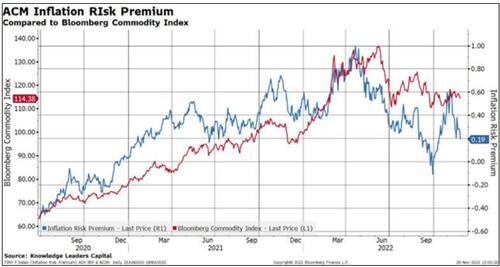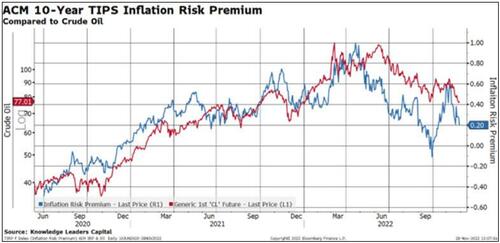Does The Inflation Risk Premium Decline Signal Lower Commodity Prices?
Authored by Steven Vanelli via Knowledge Leaders Capital blog,
There are many ways to decompose the bond market to identify the component pieces to infer what the market is pricing in.
The nominal long US Treasury bond is a function of two things:
1) the average expected future nominal short-term interest rate, and
2) the term premium.
The term premium can then be decomposed into two parts:
1) the inflation risk premium, and
2) the real risk premium.
With a little bit of algebra, bringing in some other independent variable like the inflation swap, breakeven inflation and TIPS yield, we can calculate the inflation risk premium.
The inflation risk premium tends to move in step with commodity prices whereas the real risk premium tends to move more in step with Federal Reserve policies and expectations.
What’s catching our attention is the recent plunge in the inflation risk premium and what it may mean for commodity prices.
After peaking soon after Russia’s invasion of Ukraine, the inflation risk premium signaled the peak in the Bloomberg Commodity Index in June.
Recently, since the first week of November, the inflation risk premium has dropped from 60bps to 19bps. This has coincided with mostly sideways action in the commodity index so far. But we think it does signal downside risk to commodities in the near future.
Oil is a component of the Bloomberg Commodity index, probably the most important one. It spiked on news of the Russian invasion of Ukraine but the inflation risk premium had been rising all February signaling higher oil prices ahead. Then the inflation risk premium peaked in late April, which preceded the double top in oil in June.
The signal to us from the US bond market is that oil prices may be set to fall further. The last time the inflation risk premium was around 20bps, oil prices were $64-$70/barrel.
Tyler Durden
Wed, 11/30/2022 – 13:08
via ZeroHedge News https://ift.tt/VHge4Ip Tyler Durden

